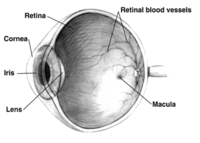
Photo from wikipedia
Supplemental Digital Content is Available in the Text. This study investigated the long-term effects of prematurity on macular morphology in adulthood indicating that fetal origins affect foveal shape, resulting in… Click to show full abstract
Supplemental Digital Content is Available in the Text. This study investigated the long-term effects of prematurity on macular morphology in adulthood indicating that fetal origins affect foveal shape, resulting in foveal hypoplasia potentially affecting the visual acuity in later life. Purpose: This study analyses whether prematurity, retinopathy of prematurity (ROP), and associated factors lead to altered foveal shape in adulthood and whether these alterations are associated with visual acuity. Methods: The Gutenberg Prematurity Eye Study is a German cohort study with a prospective ophthalmologic examination (participants aged 18–52 years) of individuals born preterm and full-term that were examined with spectral domain optical coherence tomography. Participants were grouped according to gestational age (GA) and postnatal ROP status. Multivariable linear regression analyses for foveolar retinal thickness, foveal hypoplasia, and posterior vitreous status were performed. Results: A total of 755 eyes of 414 preterm and full-term individuals were included (aged 28.6 ± 8.6 years, 233 female individuals). Central foveal retinal thickness increased as GA decreased. The prevalence of foveal hypoplasia was 2% (control group), 9% (GA 33–36), 18% (GA 29–32), 48% (GA ≤28), 50% (ROP without treatment), and 82% of eyes (with ROP requiring treatment). In multivariable analyses, central foveal thickness was independently associated with GA and advanced stages of ROP requiring treatment while foveal hypoplasia was only associated with GA. Posterior vitreous was more frequently visible as partially detached in full-term than in preterm individuals. Lower distant-corrected visual acuity correlated with increased foveolar thickness (rho = 0.08; P = 0.03) and with foveal hypoplasia (rho = 0.15, P < 0.001). Conclusion: Our findings indicate that there are fetal origins affecting foveal shape, resulting in foveal hypoplasia potentially affecting the visual acuity in adulthood.
Journal Title: Retina
Year Published: 2022
Link to full text (if available)
Share on Social Media: Sign Up to like & get
recommendations!